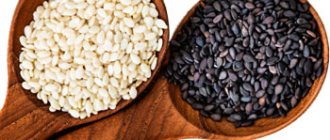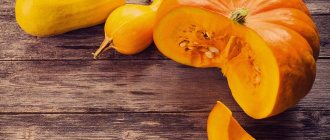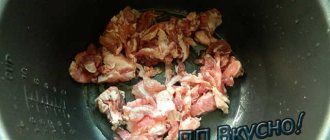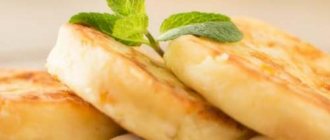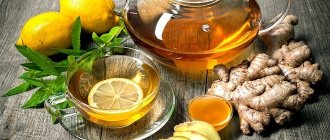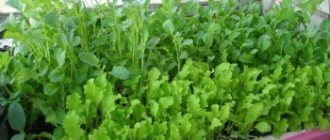Chia alba (Spanish sage) is a plant from the Lamiaceae family, native to Central America. Its seeds have healing properties and contain many useful substances (oils, vitamins, antioxidants, fatty acids, vegetable protein and minerals). Everyone should know why it is worth consuming chia seeds, their beneficial properties and contraindications for use.
Chia is white.
Composition and calorie content
White chia seeds contain many important elements:
- Ascorbic acid (vitamin C). It strengthens blood vessels and immunity, reduces the risk of infection and is involved in collagen synthesis.
- Retinol (vitamin A). Refers to fat-soluble vitamins. It promotes the growth and development of tissues and cells, improves vision in the dark, reduces the risk of developing hemeralopia, conjunctivitis and other eye pathologies, participates in the formation of bone tissue, improves the condition of the skin, nail plates and hair, promotes the proper development of the fetus during pregnancy, stimulates the formation of glycogen and synthesis of hormones, prevents the development of malignant tumors and has an antioxidant effect (slows down the aging process).
- Nicotinic acid (nicotinamide, vitamin PP). Prevents and reduces the manifestations of an allergic reaction. Participates in carbohydrate and nitrogen metabolism, reduces the level of total cholesterol and atherogenic lipoproteins (LDL and VLDL) in the blood, normalizes blood circulation in small vessels, and participates in the formation of purines and amino acids.
- Thiamine (vitamin B1). It is a coenzyme for some reactions. Improves the functioning of the nervous system, including the brain, by improving the conduction of nerve impulses.
- Riboflavin (vitamin B2). Participates in the oxidation of fatty acids and other redox processes, improves vision, maintains the normal condition of mucous membranes, reduces lethargy and drowsiness.
- Vitamin K. Refers to fat-soluble vitamins. Participates in the processes of phosphorylation, cellular metabolism and blood coagulation (prevents bleeding and hemorrhages), affects tissue calcification.
- Iron. This is a vital microelement. It is part of blood hemoglobin and cytochromes, ensures oxygen transfer and tissue oxygenation, participates in redox processes and the formation of enzymes.
- Calcium. Promotes the formation of bones and teeth. In addition, it ensures the contractility of the heart muscle, nourishes the cells of the nervous system, promotes the conduction of nerve impulses, lowers cholesterol levels and stabilizes blood pressure.
- Potassium. Supports the functioning of the excretory, nervous, musculoskeletal and cardiovascular systems. Indispensable for the heart.
- Sodium. Regulates water-salt metabolism, is part of the body's buffer systems, supports the functioning of the nervous system and muscles, promotes the formation of gastric juice, dilates blood vessels, maintains osmotic pressure of the blood, and activates glandular enzymes.
- Copper. Reduces inflammatory processes in the body and participates in redox reactions, normalizes the functioning of the thyroid gland, strengthens the immune system, and increases skin elasticity.
- Magnesium. Promotes DNA formation. Improves the absorption of other vitamins (C, B1, B6). Affects the rate of absorption and production of insulin. Affects the transmission of electrical signals to the brain.
- Selenium. This element increases a person's resistance to stress and infection. It reduces the symptoms of inflammation and prevents the formation of free radicals in the body.
- Zinc. Part of many enzymes. Affects cell growth, protein metabolism, skin regeneration processes, condition of nails and hair, strengthens the immune system and counteracts the effects of toxins.
- Phosphorus. Participates in cell division, energy formation, metabolism, enhances the formation of vitamin D and improves the functioning of the central nervous system. Phosphorus, sodium and potassium are macroelements and structural components of tissues.
- Polyunsaturated fatty acids (linolenic and others). Regulate fat metabolism, providing a hypolipidemic effect. They are antidepressants because they normalize the production of serotonin. They maintain normal hormonal levels, form myelin sheaths, participate in the synthesis of prostaglandins, reduce platelet aggregation and normalize capillary tone.
- Alimentary fiber. They make up 25% of seeds. They support normal bowel function, improve motility, normalize bowel movements and reduce the risk of developing bowel cancer.
- Vegetable protein (20% by weight of seeds). It is a source of essential amino acids and a structural component of cells, enzymes, and hormones. Provides a protective function.
100 g of seeds contain 512 kcal. Calorie content is largely determined by the presence of fats, since the breakdown of 1 g of lipids produces 9 kcal.
Composition of chia seeds.
Chia seeds benefits and harm for women and men
Beneficial properties of chia
Chia seeds are rich in a huge amount of useful substances and, according to scientific research, are recognized as a valuable source of protein. But what does this actually mean for your health?
It turns out there are a lot of things. Chia seeds are a fantastically rich source of omega-3 fatty acids. It is also a source of a number of antioxidants such as chlorogenic acid, caffeic acid, myricetin, quercetin and kaempferol, which have a positive effect on heart health, provide anti-cancer protection and work against aging of body cells.
Let's take a closer look at the beneficial properties of this superfood.
Rich in fiber
A tablespoon of chia seeds contains 5 grams of carbohydrates out of a total 21 grams. Of this amount, 4.2 grams are fiber. We all know that a low-carb diet is good for metabolism, but only when consuming digestible carbohydrates. Fiber is the indigestible part of carbohydrates, which is vital for the body. In addition to keeping your digestive tract healthy, the fiber in this superfood helps feed your gut bacteria. They are directly related to immunity and your positive mood.
Rich in Healthy Fatty Acids
The health of our heart is directly related to the condition of our blood vessels. To keep them clean it is very important to consume omega-3 fatty acids. After all, it is these compounds that are believed in the scientific world to help keep blood vessels in perfect condition. Without cholesterol plaques and various types of vascular blockages.
Contains a large amount of antioxidants
These compounds make the impossible possible: they slow down the aging of body cells. As a result, the skin looks younger and the hair is healthier. They can also significantly reduce the risk of cancer. These compounds in many products act as a fountain of youth.
Is an excellent source of protein
For those who consciously do not eat meat, finding sources of protein can be a challenge. In this case, chia seeds can come to the rescue. As much as 4 grams of protein per two tablespoons is a decent amount.
Need calcium? No problem!
Believe it or not, chia seeds contain more calcium per unit weight than dairy products. Calcium is essential for maintaining bones and teeth in good condition.
Calcium also contributes to normal muscle function. A 50g serving of this superfood contains 39% of your daily recommended value for calcium.
Well, and a lot of other useful microelements...
Iron, which contributes to the normal formation of red blood cells and hemoglobin, as well as the reduction of fatigue and fatigue. Iron contributes to normal cognitive function and normal immune system function. A 50-gram serving of chia seeds contains 28% of your daily recommended intake for iron.
Zinc, which contributes to normal fertility and reproduction, also helps maintain normal hair, nails, skin, bones and vision. Zinc also contributes to normal cognitive function and normal immune system function. A 50g serving of chia seeds contains 23% of your daily zinc intake.
Magnesium, which contributes to muscle function and protein synthesis processes. Magnesium also helps reduce fatigue and helps maintain healthy bones and teeth. A 50g serving of chia seeds contains 45% of your daily value for magnesium.
Phosphorus, which helps maintain healthy bones and teeth. A fifty gram serving of chia seeds contains 61% of the recommended daily intake of phosphorus.
Manganese helps protect cells from oxidative stress. Manganese also helps maintain normal bone health. A 50g serving of chia seeds contains 68% of the body's daily requirement for manganese.
Selenium contributes to the protection of cells from oxidative stress and normal immune system function. Selenium also contributes to normal thyroid function. A 50g serving of chia seeds provides 50% of your daily selenium intake.
It also contains thiamine (vitamin B1), which contributes to normal heart function. It also contributes to normal energy metabolism. A 50g serving of chia seeds contains 28% of your daily value for thiamine.
Niacin (vitamin B3), which helps reduce tiredness and fatigue. A 50g serving of chia seeds contains 28% of the daily recommended intake of niacin.
Contraindications or possible side effects when consuming chia seeds
Of course, the beneficial properties of chia seeds for women and men are undeniable. But this does not mean that under certain conditions their use can be harmful.
Here are five potential risks of taking this product.
1.Gastrointestinal problems
According to scientists, some people may experience gastrointestinal problems when consuming chia seeds in the form of diarrhea, bloating and the formation of excess intestinal gas.
These problems can affect your well-being. Therefore, pay attention to how you feel, the amount of product you consume and in what dishes you use it. It should be mentioned that these kinds of problems arise due to the high fiber content of this superfood.
If your body is not used to high fiber intake, increase the amount of chia seeds gradually and try to drink plenty of water. Also, don't go overboard with the quantity as I mentioned above. The usual daily value is a tablespoon of seeds, containing 69 calories.
One study presented to the American College of Gastroenterology in 2014 described how a patient who first consumed dry chia seeds and then a glass of water ended up developing a blockage in the esophagus—because the chia seeds absorbed water and expanded in the patient's throat. To avoid this, do not eat them dry. Include them in various dishes or mix them with water when consumed.
2.Low blood pressure and bleeding
Due to the high content of Omega-3 fatty acids in this product, a decrease in viscosity and blood thinning is possible. It can also lead to a drop in blood pressure. Especially if you have already had similar problems before. If you have a history of low blood pressure or are taking any blood thinning medications, be sure to consult your doctor before adding chia to your diet.
3.Effect on blood sugar levels
While chia seeds can help regulate glucose levels, they can also overstimulate medications that control blood sugar. If you have been diagnosed with diabetes, be sure to seek professional advice when consuming chia.
4.Allergies
Getting an allergy from chia seeds may be unexpected, but some symptoms of an allergy to this food may still include rash, hives, and watery eyes. Food allergy symptoms such as breathing problems, vomiting, diarrhea and tongue swelling may also occur.
5. Potential effect on pregnant women
Although the effect of chia seeds on pregnant women is not fully known, most scientists are of the opinion that it is better for pregnant and breastfeeding women to avoid taking this product.
Until more scientific research is done.
Again, I in no way want you to refrain from including chia seeds in your diet.
After all, their positive properties for women and men are widely known. Just before taking it, it is best to assess your health condition and consult a doctor if necessary.
Benefits of chia seeds
Chia plant seeds are beneficial for adults and children. This product can be used during pregnancy and breastfeeding.
For vegetarians
Chia seeds are good for the health of people who, due to their beliefs, do not eat food of animal origin. Chia contains protein, which can partially replace the protein in meat. This also applies to polyunsaturated fatty acids omega-3 and omega-6, which are found in large quantities in fatty fish. Chia seeds are also rich in them. This product contains a large amount of calcium - 5 times more than milk. This is important for strengthening bones, preventing osteoporosis and osteomalacia.
For women
The seeds affect the female body in the following ways:
- Promotes weight loss. This is important for overweight women who want to have a beautiful figure.
- They improve the condition of skin, hair and nails thanks to the vitamins and zinc they contain. Hair becomes shiny, silky, and does not fall out in large quantities.
- Slow down the natural aging processes (the appearance of wrinkles, decreased skin turgor).
- They have a positive effect on the fetus.
- Helps restore strength and tissue in the postpartum period.
- Reduce levels of stress, anxiety and depression.
For men
Chia seeds for men.
Regular consumption of chia by men reduces the risk of developing prostate cancer.
This plant improves the condition of seminal fluid, strengthens the heart, and increases performance.
It is often used by athletes after training.
Are chia seeds ok during pregnancy?
During the period of bearing a child, a woman’s body experiences a double need for vitamins and minerals, since they are consumed very quickly. The benefit of chia seeds for pregnant women is that the product is able to saturate the body with the most essential elements - potassium, calcium, fatty acids. The fiber content promotes good digestion and prevents constipation.
We recommend reading: Diet for gastritis: table 5, 4, 3, 2, 1
However, before introducing the product into the diet, a pregnant woman should consult a doctor; chia remains a rather exotic product. You should make sure that there are no strict contraindications and the seeds will not cause harm.
Features of use
The seeds are eaten in various forms. This largely depends on the physiological state and preferences.
During pregnancy
This healthy product can be consumed by pregnant women in any trimester. In case of allergies, chia should be avoided. Taking chia in large quantities can lead to bloating and bowel dysfunction. It is recommended to eat 1-2 tbsp. l. seeds per day.
It is better to soak the seeds first, but no special heat treatment is required. The seeds are most useful when eaten raw. You can also add them to decoctions, porridges, smoothies, and yoghurts. Chia does not contain folic acid, cholecalciferol, pantothenic acid and tocopherol, so you must additionally eat foods rich in these vitamins.
When breastfeeding
Chia seeds increase milk production and enhance its beneficial properties, so they are useful to take during lactation. It is recommended to add seeds to boiled and stewed foods. You cannot prepare sweet porridges, bean and cabbage dishes, or curd pastes using chia, as they enhance fermentation processes. Decoctions and infusions are useful, since the formation of breast milk requires 1.5 liters of liquid daily.
For children
Chia seeds for children.
Children are more in need of calcium and vitamins, which are contained in chia.
It is not recommended to give seeds to children if they are taking antibiotics, Aspirin and other NSAIDs, or if they have a history of digestive diseases and arterial hypotension.
You can eat the seeds raw. In this case, before use, pour 1 tbsp. l. warm water.
It is useful to add seeds to puddings, cereals, yoghurts, cottage cheese, and vegetable dishes. The daily dose for children is 3-4 times less (1-1.5 tsp).
Methods of use
Chia seeds can be used dry or soaked. The latter method is more preferable, since grains, when they enter the stomach, absorb moisture and swell, which negatively affects digestion.
Preparing the product for use:
- wash the seeds;
- soak for 1-2 hours.
For 1 tbsp. l. 200 ml of water (not boiling water) or milk is enough for grains. After the seeds swell, they can be consumed, added to salads, cereals, yogurts, milkshakes, jelly, smoothies.
Note! It is recommended to consume the finished grains immediately; they are not suitable for storage.
Other uses for chia seeds:
- Consuming grains in pure form or powder. The dry product should be washed down with plenty of water or juice.
- Adding grains to baked goods: cookies, muffins, bread, pancakes.
Chia seeds taste similar to walnuts. They do not lose their medicinal properties even during heat treatment.
Watch the video for three delicious chia recipes:
To increase tone
To feel more energetic and feel a surge of strength, it is enough to eat 1-2 tbsp. l. product in the morning. You can use both ground and whole grains.
For gastritis, pancreatitis
You can include chia in your diet only if you have a chronic form of these diseases. During the acute stage, seeds should not be consumed, as they are rich in fiber, which can increase irritation and inflammation of the gastrointestinal mucosa.
You should only take soaked seeds, and preferably crushed ones. They need to be drunk 1/2 tsp. 3 times a day before meals. The course of treatment is 1 month. You can resume taking it after a week.
For constipation and bowel cleansing
To cleanse the intestines of waste and toxins, as well as normalize peristalsis, you can prepare a healthy cocktail. You will need the following ingredients:
- 200 ml kefir;
- 1 tbsp. l. chia;
- 2 tsp. liquid honey.
Soak the grains in kefir for 2 hours, add honey. This cocktail can be drunk for 3 weeks in the morning on an empty stomach.
Note! During the course, it is recommended to increase fluid intake to 2 liters of water per day.
For diabetes
It is impossible to replace the antidiabetic drug with seeds, but they can increase the effectiveness of treatment. You need to use grains ground into powder. They should be consumed 1/2 tbsp. l. 2 times a day with meals.
To lower cholesterol levels
The dosage regimen is similar to that for diabetes mellitus, but at the same time you need to follow a diet. Also, fried and fatty foods and spicy seasonings should be excluded from the diet.
For weight loss
The most valuable for weight loss are sprouted chia seeds. But they must be taken correctly, otherwise grains can cause harm instead of benefit. At first it is recommended to consume several sprouts per day, then gradually increase to 7-8 pieces.
If there is no time for germination, you can limit yourself to whole grains. They should be consumed before each meal, 1 tsp, with 200 ml of water. Course – 1-1.5 months.
When you suffer from severe hunger while losing weight, you can satisfy it with jelly made from seeds. You need to soak 1 tbsp in one glass of hot water for 30 minutes. l. grains The resulting mucous liquid can be consumed up to 3 times a day, half an hour before meals.
Navitas Organics, Organic Chia Seeds, 454 g
★★★★★
from 753 ₽
More details
How to use chia seeds for weight loss
The plant is used to combat excess weight. Weight loss is achieved by cleansing the intestines and the entire body of toxins. The plant acts similarly to flax seeds. The protein it contains, unlike animal protein, is not deposited in the form of waste. An important property of chia is its ability to burn fat. Omega-3 acids are responsible for this.
Chia chlorogenic acid reduces appetite. You need to eat chia seeds for weight loss with water or vegetables, low-fat or low-fat dairy products.
How to take chia seeds for medicinal purposes
Chia seeds are used as a traditional medicine.
For pancreatitis
For inflammation of the pancreas, chia is used as an anti-inflammatory agent. Seeds can be taken in 15 g doses, dividing the daily dose into 3 doses. The plant does not need to be washed as it swells quickly. Chia must first be soaked in milk or water in a ratio of 1:10. As a result, a film is formed that improves the passage of the product through the intestines. The duration of treatment of pancreatitis with seeds is 1 month.
For diabetes
People with diabetes need to eat more protein and fiber, which chia seeds are rich in. They need to be added little by little to the daily diet. The seeds do not have a specific taste, so they can be added to prepared dishes or eaten raw. The plant cannot replace drug therapy and diet, so treatment must be comprehensive.
For gastritis
Chia seeds for gastritis.
The seeds contain substances that form mucus after entering the stomach. It has an enveloping effect, protecting the mucous membrane from gastric juice and thereby reducing inflammation. It is recommended to drink a decoction or infusion of seeds.
To prepare the mixture you will need 1 tbsp. l. plants and 2 glasses of hot water. Infuse the seeds for 1 hour. The resulting infusion is cooled and taken 2-3 sips before meals. The broth takes longer to prepare. It is drunk 15-30 minutes before meals in the morning, during the day and before bed.
For constipation and bowel cleansing
The large amount of fiber in the seeds helps cleanse the intestines of feces and fecal stones. The plant improves intestinal motility, which helps combat constipation.
To prepare a cocktail that cleanses the intestines, you will need 200 ml of water, 1 tbsp. l. chia, 1 tbsp. l. fresh honey, 1 tbsp. l. flax seeds and 1 apple. The resulting ingredients are mixed in a blender and left for 10 minutes. You should drink the cocktail in the morning on an empty stomach. You can eat food only after an hour.
To lower cholesterol
A valuable property of chia is its ability to reduce cholesterol levels. This is important for people with excess weight, dyslipidemia, coronary heart disease and atherosclerosis. If cholesterol levels are high, seeds can be added to dietary dishes (boiled lean meat, vegetable stews, non-rich soups). At the same time, not animal fats, but vegetable fats should predominate in the diet.
Can I have chia seeds at night?
Chia seeds can be consumed at any time of the day, and especially, and even preferably, consumed before bed - to launch metabolic processes in the body. Eating chia seeds at night is possible according to the recipe “Night cocktail for weight loss with kefir” . Such a recipe was described above.
Combine chia seeds and kefir, then leave for 1-2 hours . Before use, add honey and you can also add half a teaspoon of cinnamon. Stir until smooth - the night weight loss cocktail is ready to drink.
The use of chia seeds in home cosmetology
Chia plant seeds are widely used in cosmetology due to the presence of antioxidants (ascorbic acid, zinc, selenium, vitamin A). They are used to prepare face masks, scrubs and oils.
For hair
Chia seeds for hair.
To improve hair condition, use chia seeds with lemon juice.
Add 1/3 cup of chia to 500 ml of water, shake and leave for 5 minutes. Then place the resulting mixture in the refrigerator to thicken.
After 15 minutes, add 3 tbsp. l. lemon juice. The mixture is applied to the hair for 10 minutes and then washed with cool water.
Facial scrubs
People with oily skin benefit from using scrubs based on this plant. Such scrubs normalize the functioning of the sebaceous glands and reduce breakouts. The mixture should be applied only to a dry face. To prepare it you will need 2 tbsp. l. chia and honey and the pulp of half an apple. The resulting mixture is applied to the skin for half an hour and then washed off. A scrub based on coconut oil, chia and citrus juice is no less effective.
Face masks
To prepare a face mask, take 2 tbsp. l. chia and water, add 3 tsp to them. olive oil and honey and mix thoroughly. Apply the resulting mask to a previously cleansed and dry face. After 30 minutes, remove the mixture with napkins or a towel and wash your face with water.
Properties and uses of chia seed oil
Chia seed oil.
The oil is obtained by pressing the seeds. It has the following beneficial properties:
- helps in the treatment of respiratory diseases such as bronchitis and pneumonia;
- relieves nervous tension;
- reduces migraines and seizures;
- removes toxic substances from the body;
- helps with drug addiction;
- improves the functioning of the liver and other organs of the digestive tract;
- reduces pain from rheumatism and neuralgia;
- reduces the manifestations of Alzheimer's disease;
- helps in the fight against genitourinary infections.
Chia seeds in cooking
Seeds are added when preparing various dishes:
- cake;
- pudding;
- panna cotta;
- smoothie;
- jam;
- marshmallows;
- porridge.
Chia seed muffin.
This product acts as a binder similar to eggs and butter.
Chia seed porridge
To prepare porridge you will need 100 g of cereal or flakes, 50 g of chia, 0.5 liters of boiling water or milk. You can also add sugar, salt, berries and fruits. When chia is placed in liquid, the seeds swell greatly and give the dish the desired texture. Many people will like porridge based on chia and oatmeal. Porridge with chia, millet and pumpkin will be no less tasty. To prepare it you need 100 g of pre-baked pumpkin, 100 g of millet cereal, 1 tbsp. l. chia, butter, salt, sugar.
Smoothie with chia seeds
There are a lot of recipes for making smoothies. A smoothie is a thick drink based on fruits or berries with the addition of liquid (juice, milk). To obtain such a cocktail you will need 200 g of sweet apricots, 1 tbsp. l. fresh honey, 200 ml kefir and 3 tbsp. l. pre-soaked chia seeds. The ingredients are mixed and blended in a blender. You can drink the drink in the morning or after sports training. Instead of apricots, you can use strawberries, bananas, mangoes and other fruits and berries to taste.
Recipes for dishes with seeds
Salvia hispanica seeds have virtually no taste. Therefore, they can be painlessly added to any dish. The most popular method of administration is to use it to prepare healthy nutritional cocktails and a variety of desserts.
5 cocktail recipes for cleansing the body and losing weight by Dr. Mark Hyman
General rules for preparing medicinal cocktails
All offered cocktails, or smoothies, call them whatever is more convenient for you, are prepared according to the same rules.
- The ingredients are placed in a blender and blended until smooth.
- If you want to get a liquid cocktail, pour water so that in the blender glass it is 3-5 cm above the ingredients.
- If you want to eat the mixture with a spoon rather than drink it, you should add less water.
- Take only pre-soaked chia seeds.
- Other seeds and nuts are also pre-soaked (for at least half an hour, or even overnight).
- Use only raw nuts and seeds (not roasted, not salted).
- Berries can be taken either fresh or frozen. The same rule is true for some types of greens, for example, spinach.
- Other herbs and spices, such as ginger, should be fresh (not dried). Except cinnamon. Of course, they take it dry and can already be ground.
Protein shake for breakfast
- ½ cup cranberries;
- ½ cup blueberries;
- ¼ lemon with peel;
- 1 tbsp. spoon of nut butter;
- 1 tbsp. spoon of chia seeds;
- 1 tbsp. spoon of pumpkin seeds;
- 2 walnuts;
- 2 Brazil nuts;
- ¼ avocado
- ½ tbsp. spoons of coconut oil;
- ½ cup almond milk;
- about half a glass of water.
Kiwi smoothie
- 1 kiwi;
- ¼ avocado;
- 4 tbsp. spoons of chia seeds;
- lime juice;
- ¼ small bunch of mint;
- 1 cup spinach leaves;
- about 1 glass of water.
Cucumber-ginger smoothie
- ½ cup almonds;
- 2 kale leaves;
- 4 tbsp. spoons of chia seeds;
- 0-1.5 cm of ginger root;
- half a medium sized cucumber;
- about 1 glass of water.
Almond cocktail with spices
- 1 tbsp. spoon of almond oil;
- 1 tbsp. spoon of chia seeds;
- ¼ avocado;
- 1 leaf kale;
- ¼ medium sized cucumber;
- ¼ lime (without peel);
- 8-10 mint leaves;
- 0-1.5 cm of ginger root;
- ½ tbsp. spoons of coconut oil;
- about 1 glass of water.
Strawberry smoothie
- 1 tbsp. spoon of almond oil;
- 3 walnuts;
- ½ cup strawberries;
- ¼ avocado;
- 0-1.5 cm of ginger root;
- ¼ teaspoon cinnamon;
- 1 tbsp. spoon of chia seeds;
- about a glass of water.
Baking and dessert recipes
Coconut mango pudding
Quite an exotic-tropical recipe. Not the cheapest, but simple.
Oat pudding
A simpler, more nutritious version of chia seed pudding. But it cannot do without tropical components, for example, banana.
Peanut butter pudding
It is better to replace peanut butter in this recipe with homemade peanut butter, and exotic carob with regular cocoa.
Oat pancakes
The maple syrup in this recipe can be replaced with regular sugar, since at its core maple syrup is sugar, only beautiful. You can use regular milk instead of almond milk.
Chocolate nut bars
This recipe calls for almonds or pistachios. But really, you can use any nuts you like.
Nut and oat bars with dried fruits
This recipe uses different dried fruits and different nuts. So you have a lot of room for creativity.
Lemon Chia Seed Cake
Just add chia seeds to this recipe. Regular flour is used as the main component of the dough. Therefore, be careful - the baked goods are not gluten-free.
Apple-berry muffin
The same as with the previous recipe: regular flour is included in the recipe. Chia seeds just give it an extra twist.
Strawberry jam
You can make real jam with chia seeds without adding pectin, since the seeds themselves form an excellent jelly-like mass.
Wheat bread with chia
The seeds in this recipe are added dry to taste. Regular flour is used - baking wheat.
How to select and store chia seeds
High-quality chia seeds should be rich white or black in color, without signs of spoilage, with a shiny surface, without an unpleasant odor (a high-quality product has practically no smell). Brown color indicates their immaturity, improper storage or poor growing conditions. These chias often have a bitter aftertaste. Upon contact with water, the plant quickly secretes a jelly-like mass. Store raw materials for no more than 24 months in a dry, dark and cool place. High humidity levels can cause product spoilage.
Opinions of doctors and reviews of those who took
Valeria, 42 years old, Voronezh: “I have been using this product for 2 weeks during the day and evening. The result is obvious. My appetite decreased, as a result of which I lost 2 kg. Excellent product for weight loss."
Veronica, 33 years old, Moscow: “I use chia to lower blood pressure. It helps a lot."
Oleg, 35 years old, nutritionist: “Chia is a natural, low-calorie and healthy product of plant origin, which perfectly helps with obesity and allows you to enrich the body with vitamins, fiber and mineral compounds. Taking chia alone is not enough for weight loss. Additionally, you need to increase physical activity and follow a strict diet.”
If you find an error, please select a piece of text and press Ctrl+Enter.


